A few years back, if you had heard the words AR or VR, then it was mostly about gaming, but not anymore. New and innovative ways of engaging with brand audiences are coming through in AR/VR in marketing and advertising. Space to create new storytelling avenues and better-personalized strategies for marketing by marketers can be seen coming through. AR/VR in marketing and advertising has become an interactive, immersive, and memorable experience for customers.
In this blog, we have put together how AR/VR in marketing and advertising is shaping the future of customer engagement.
How Do Companies Offer Augmented Reality Virtually?
The times when people needed to go to shops to buy things, they are, well, simply put, not trendy anymore. Although, some might disagree! The new and immersive world of AR and VR has changed the way people shop. It allows interaction with the product rivetingly. Real-time experience of how the product behaves or works makes the buyer experience the journey of buying a product. A lot of shopping apps have the feature of augmented reality where the buyer can see how the product feels in their hand or their room. This feature has the ability to boost customer satisfaction.
Virtual showrooms help the buyer understand the product, mimicking the actual product from the physical store of the brand. This gets the buyer to imagine the product before even buying it and, in turn, creates the excitement to own it. Virtual spaces do what a salesperson is doing at the physical store but in a more creative and fun way. Smart stuff!
How Does AR Work In-Store?
Superimposition of a product over a buyer’s image virtually using AR tech like AR mirrors is how the buyers can try on clothing, cosmetics, or accessories using their phones. This allows people to understand how it would feel if that product was on them without actually trying it on. The time it takes to put on all the items that we like is substantially reduced.
It’s not just clothing; the try-ons are used in multiple products like home décor, furniture, etc., how a TV would look mounted on your wall, how a recliner would fit, or how a wall would look when painted, to mention some. The guesswork for the buyer is eliminated. Pretty handy equipment!
How do VR Simulations Work?
The simulation of feeling that you’re somewhere when you aren’t there is done by VR simulations. This simulation helps you explore the hotels and destinations before going through the bookings so that you don’t regret it later and waste your money if you don’t like it. This system actually works as a win-win situation for the buyer and the seller as well, as the sheer thought of experiencing the destination is mostly convincing enough for the buyer, and that’s how VR simulations work.
Simulations for activities like concerts and meetings are now a common approach. Real estate is another field where VR is used effectively. Virtual tours have become more accessible and easier to create. For example, using a 360° camera like those offered by Giraffe360 allows you to accurately capture properties. Many AI-powered tools can then enhance these tours further with features like interactive elements and customization. People can get a feel of walking through the homes. The option to customize the colors, furniture, layouts etc. can be used. This just makes the journey of buying the estate easier and more immersive.
Future that AR/VR in Marketing and Advertising Holds!
The interactive storytelling of AR/VR in marketing and advertising has set so many narratives past the traditional consumer storytelling experiences. Augmented reality allows brands to superimpose digital content onto the real world; this guides the consumers through the storylines as they unfurl. These virtual environments have the ability to create properly realized worlds where the consumer has the option to explore them at their own pace.
User-generated content is one of the most genuine kinds of marketing. Entailing user-generated content (UGC) into AR/VR activities can inspire the consumer and engage in the community on a far greater level. Consumers can make their own content with the use of augmented reality and share it on social media. Interested customers can be influenced by seeing these social media activities. Overall, it has all the benefits for marketing and immersive consumer experiences.
Parting Words to Keep in Mind!
Augmented and virtual reality systems in marketing introduce revolutionary changes because they provide immersive experiences that build stronger brand relationships with better consumer engagement. These technologies will advance through development to fundamentally shift marketing methods, thus producing more reactive and powerful solutions.
The initiation of augmented and virtual reality into daily activity creates new ways to experience environments by developing better experiences within educational and entertainment fields as well as healthcare services. These developing technologies create prospects to reshape how people see and communicate with their surrounding environment.
For more information on such topics, visit HiTechNectar now!
You May Also Like:
Data Visualization in AR and VR
Understanding Mixed Reality: A Combination of AR & VR


